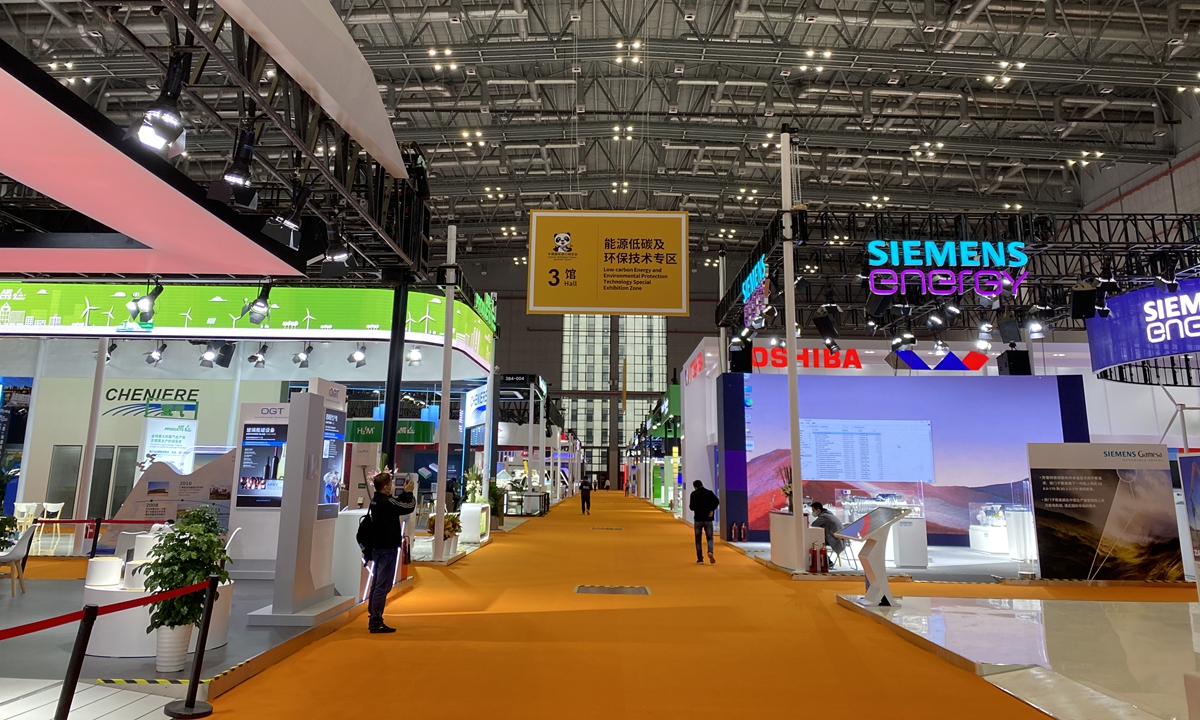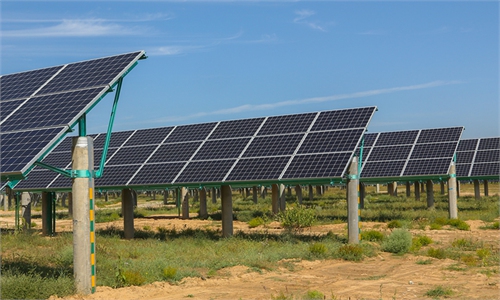At the CIIE, foreign firms eye historic opportunities in China’s green push
Businesses showcase products, services to support China’s carbon goals

Low-carbon Energy and Environmental Protection Technology Special Exhibition Zone at the 4th CIIE in Shanghai on November 4, 2021 Photo: Xie Jun/GT
China's "dual carbon" goals are expected to unleash vast market opportunities for foreign companies to hitchhike on what will be the biggest "green revolution" in the coming decades, some foreign company executives told the Global Times at the 4th China International Import Expo (CIIE).
As China beefs up efforts to achieve its carbon goals, "low carbon" became a buzzword at the 4th CIIE, which kicked off in Shanghai on Thursday.
This year, a special area called "low-carbon energy and environmental protection technology exhibition zone" was set up, which attracted about 50 global companies to exhibit carbon-related products and technologies.
On Thursday morning, ahead of the opening of the 4th CIIE, all of the booths in the low-carbon zone were well organized and ready to receive guests.
Many companies are showing products that can help Chinese companies shift to clean energy. The US firm DuPont, for example, is displaying special materials that are used in photovoltaic modules.
US-based Johnson Controls is displaying solutions for zero-carbon architecture, while Covestro is showing how its technology can replace fossil fuels.
Also, a number of companies put boards on their booths that showed how they are going to adopt low-carbon solutions in their plants. Emerson, for example, promised to cut its greenhouse gas emissions intensity by 20 percent in 185 of its global entities.
The general manager of DuPont China, Mac Chen, said that DuPont's own commitment to achieve the goal of carbon neutral operations by 2050 is very clear, so it will actively respond to the "dual-carbon" goal proposed by the Chinese government.
For example, the company's backplane material installed on the roof of DuPont's R&D center in Shanghai can generate about 150-200 kilowatts of clean energy a year.
Based on long-term experience in cooperating with local large power companies, including large power stations in Northwest China's Qinghai Province, DuPont has been able to introduce some innovative products to apply new technologies, such as bifacial modules and bifacial power generation.
These new products can achieve double-sided power generation to reduce the cost of electricity, so that its life can exceed 30 years, Mac said.
"In the past 40 years of China's reform and opening-up, there have been many changes in the market, and we also need to know what China's future development trends are," Mac said.
While innovation has become the main driving force of China's next-stage economic growth, with cutting-edge areas such as big data and artificial intelligence to be the new strategic focus in the 14th Five-Year Plan (2021-25) period, Mac said that the company will also think about what products and solutions DuPont can provide, based on these strategies.
DuPont is not alone in terms of gaining growing benefits from China's low-carbon strategic goal.
In its 2021 fiscal year, IKEA revamped all its shops in the Chinese mainland with the aim of bringing more inspiration for healthy and sustainable living, and encouraging consumers to buy products with sustainability elements. The Swedish company has more than 4,000 sustainable products, and sales of sustainable products in the 2021 fiscal year exceeded IKEA's expectations at 27.4 percent of total sales.
Anna Pawlak-Kuliga, CEO and president of IKEA China, told the Global Times on Thursday that she has high expectations of how China's low-carbon commitment can work with that of IKEA.
"IKEA has been actively exploring more sustainable home solutions for years and invested in building a more sustainable value chain with circularity as a focus... IKEA thinks that China's pledge on carbon peak and carbon neutrality will help us to achieve our goals," she said. IKEA is promoting zero-emissions delivery for consumers across China.
As of this year, IKEA China had made 90 percent of its customer deliveries purely electric in order to reduce carbon emissions, according to the company.
"Economic recovery must be green and low-carbon, which is the consensus in all walks of life around the world, while China's 'dual carbon' goals demonstrate the responsibility of a major country and also bring more development opportunities for energy management and digital transformation," Yin Zheng, executive vice President of Schneider Electric and president of Schneider Electric China, told the Global Times.
A recent survey by Schneider Electric shows that 94 percent of Chinese companies are willing to use digitalization for corporate carbon governance.
"With our energy management expertise and digital advantages, we are committed to promoting the transformation of China's industries and moving toward a sustainable and green future together," Yin said.

Low-carbon Energy and Environmental Protection Technology Special Exhibition Zone at the 4th CIIE in Shanghai on November 4, 2021 Photo: Xie Jun/GT
China's "dual carbon" goals are expected to unleash vast market opportunities for foreign companies to hitchhike on what will be the biggest "green revolution" in the coming decades, some foreign company executives told the Global Times at the 4th China International Import Expo (CIIE).
As China beefs up efforts to achieve its carbon goals, "low carbon" became a buzzword at the 4th CIIE, which kicked off in Shanghai on Thursday.
This year, a special area called "low-carbon energy and environmental protection technology exhibition zone" was set up, which attracted about 50 global companies to exhibit carbon-related products and technologies.
On Thursday morning, ahead of the opening of the 4th CIIE, all of the booths in the low-carbon zone were well organized and ready to receive guests.
Many companies are showing products that can help Chinese companies shift to clean energy. The US firm DuPont, for example, is displaying special materials that are used in photovoltaic modules.
US-based Johnson Controls is displaying solutions for zero-carbon architecture, while Covestro is showing how its technology can replace fossil fuels.
Also, a number of companies put boards on their booths that showed how they are going to adopt low-carbon solutions in their plants. Emerson, for example, promised to cut its greenhouse gas emissions intensity by 20 percent in 185 of its global entities.
The general manager of DuPont China, Mac Chen, said that DuPont's own commitment to achieve the goal of carbon neutral operations by 2050 is very clear, so it will actively respond to the "dual-carbon" goal proposed by the Chinese government.
For example, the company's backplane material installed on the roof of DuPont's R&D center in Shanghai can generate about 150-200 kilowatts of clean energy a year.
Based on long-term experience in cooperating with local large power companies, including large power stations in Northwest China's Qinghai Province, DuPont has been able to introduce some innovative products to apply new technologies, such as bifacial modules and bifacial power generation.
These new products can achieve double-sided power generation to reduce the cost of electricity, so that its life can exceed 30 years, Mac said.
"In the past 40 years of China's reform and opening-up, there have been many changes in the market, and we also need to know what China's future development trends are," Mac said.
While innovation has become the main driving force of China's next-stage economic growth, with cutting-edge areas such as big data and artificial intelligence to be the new strategic focus in the 14th Five-Year Plan (2021-25) period, Mac said that the company will also think about what products and solutions DuPont can provide, based on these strategies.
DuPont is not alone in terms of gaining growing benefits from China's low-carbon strategic goal.
In its 2021 fiscal year, IKEA revamped all its shops in the Chinese mainland with the aim of bringing more inspiration for healthy and sustainable living, and encouraging consumers to buy products with sustainability elements. The Swedish company has more than 4,000 sustainable products, and sales of sustainable products in the 2021 fiscal year exceeded IKEA's expectations at 27.4 percent of total sales.
Anna Pawlak-Kuliga, CEO and president of IKEA China, told the Global Times on Thursday that she has high expectations of how China's low-carbon commitment can work with that of IKEA.
"IKEA has been actively exploring more sustainable home solutions for years and invested in building a more sustainable value chain with circularity as a focus... IKEA thinks that China's pledge on carbon peak and carbon neutrality will help us to achieve our goals," she said. IKEA is promoting zero-emissions delivery for consumers across China.
As of this year, IKEA China had made 90 percent of its customer deliveries purely electric in order to reduce carbon emissions, according to the company.
"Economic recovery must be green and low-carbon, which is the consensus in all walks of life around the world, while China's 'dual carbon' goals demonstrate the responsibility of a major country and also bring more development opportunities for energy management and digital transformation," Yin Zheng, executive vice President of Schneider Electric and president of Schneider Electric China, told the Global Times.
A recent survey by Schneider Electric shows that 94 percent of Chinese companies are willing to use digitalization for corporate carbon governance.
"With our energy management expertise and digital advantages, we are committed to promoting the transformation of China's industries and moving toward a sustainable and green future together," Yin said.



